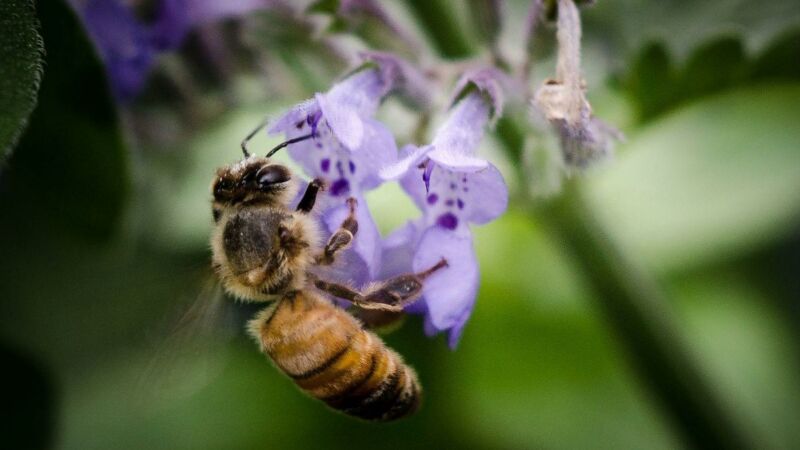Pollinator habitats and solar farms may seem like ecologically great neighbors, but we still don't understand very much about that relationship. A team of researchers recently published a paper surveying the ins and outs of keeping solar production alongside the kinds of plants that pollinators like bees and butterflies love. The paper notes that there's a good amount of potential here, but more work needs to be done to fully understand the potential partnership.
“I think in some ways, it sounds like a no-brainer that we should be implementing pollinator habitats at these types of facilities. And on one hand, I agree with that, but I think it really does benefit us to figure out the most efficient ways to get these kinds of benefits out there,” Adam Dolezal, assistant professor at the University of Illinois at Urbana-Champaign's department of entomology, told Ars.
More than 100 crops in the US rely on pollinators. However, around the world, the number of pollinators has been in decline. Habitat loss is a significant reason for the decline, though there are others, including climate change and invasive species.
Currently, Illinois, Vermont, Maryland, Michigan, Minnesota, Missouri, New York, and South Carolina have enacted legislation to promote the creation of pollinator habitats alongside solar developments. These eight states have also developed scorecards to determine if a site is ideal for a habitat. Illinois, one of the first states to pursue the practice, developed its own scorecard around four years ago. Other states are newer to the party, and the rest haven't started at all.
“There isn't that much work experimentally or in terms of observational testing in these sites,” Dolezal said.
To bee or not to bee?
Solar-pollinator partnerships hold potential. Normally, solar facilities are surrounded by grass or gravel. Adding a pollinator habitat could simply be a better, more efficient use of the land and ideally increase pollinator numbers, which could have a positive impact on surrounding ecosystems.
There's also a PR element for the companies involved. Some people don't want to live near solar farms simply because of how they look. But planting pollinator habitats in between the panels could make the prospect seem more appealing to a community in general.
In or near rural areas, an increase in pollinators may be beneficial to crops. The plants in the region could also make the solar rigs more effective, as they cool the area (solar panels tend to work better when cool). Dolezal noted, however, that it's too early to say that either of these theories would be true in practice. We also don't know whether turning every solar facility into a habitat will have a meaningful impact in terms of pollinator health. Dolezal suspects it will, but studies will need to address the other problems the pollinators face.
Further, these kinds of mixed-use operations represent some practical challenges that might hinder their adoption. Even something as simple as the height of the plants is a consideration, since, at many solar facilities, the panels sit only 18 inches off the ground. Milkweed, an essential food source for monarch butterfly caterpillars, can grow well above this height and potentially block the sun from reaching the panels.
Creating these gardens can cost developers a lot of money, as can their maintenance. To be effective pollinator habitats, the area should ideally be covered in a variety of native plants. Setting this up can be tricky, as some plants have different growing requirements, and this diversity can also represent a development cost—which can be large if the cost is multiplied over thousands of acres.
Diversity is key
Paul CaraDonna, a conservation scientist with the Chicago Botanic Garden's science department, said mixing solar power and pollinators is a great idea, particularly in the Midwest, where there's a good deal of agriculture. “We have to put solar panels someplace, and I'd much rather a pollinator habitat be planted or set up around these solar farms as opposed to gravel,” he told Ars. “The more pollinator habitats we can create, the better.”
There are some caveats, however. For example, converting previously wild areas into solar farms, even with pollinator habitats attached, could potentially do more harm than good. Pristine habitats should instead be kept as is, CaraDonna said.
It's also important to ensure that the habitats developed are actually useful to pollinators. Having a habitat filled with diverse and native species could help both pollinators and other species, CaraDonna noted. As such, it's important that companies don't cut corners by defaulting to the bare minimum. Developers would need to take into account the different growing schedules of the plants—if you only plant species that bloom in June, for example, some pollinator species would not have food for the rest of the summer.
“That would be better than nothing,” CaraDonna said. “While I think three [plant species] is better than two or better than one, it's not actually that many in the end.”
In all, this technique and its associated state scorecards will need to evolve, Dolezal said. In order for the developments to be effective, we need more research into what does and does not work ecologically and practically. Dolezal's paper suggests that a third party should be involved in assessing the health of the systems. The scorecards need to have strict enough criteria to get results—but also provide enough leeway so developers will pursue the goals, he said.
“We should be interested in trying to see the most efficient way to improve pollinator health, while still being consistent with what the realities of the developments are,” he said.
Environmental Entomology, 2021. DOI: 10.1093/ee/nvab041 (About DOIs).



3175x175(CURRENT).thumb.jpg.b05acc060982b36f5891ba728e6d953c.jpg)

Recommended Comments
There are no comments to display.
Join the conversation
You can post now and register later. If you have an account, sign in now to post with your account.
Note: Your post will require moderator approval before it will be visible.